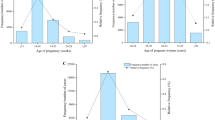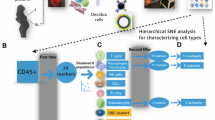Abstract
We describe a single centrifugation procedure that resulted in the recovery of fetal cells in maternal blood in 77% of normal male pregnancies and in 87.5% of aneuploid pregnancies. There was an average yield of one fetal cell/1,993 maternal cells in normal pregnancies, which increased to one in 994, in aneuploid pregnancies.
Similar content being viewed by others
We report our experience in recovering fetal cells from maternal circulation as a step toward performing noninvasive prenatal diagnosis. We have been successful in obtaining fetal cells from the plasma fraction of maternal blood using a modification of the technique reported by Poon et al. (2000) and in contrast to the negative results reported by Bischoff et al. (2003).
A total of 30 cases were studied, nine of which were controls. Following informed consent, blood samples were drawn into heparinized tubes from 28 pregnant women seeking prenatal diagnosis 10–22 weeks’ gestation, 21 of whom were deliberately selected because they were carrying a male fetus determined independently by fluorescent in situ hybridization (FISH). The remaining seven samples, from women carrying a female fetus, served as controls; three were from women without a history of a male pregnancy, and four were from women with a male pregnancy history. Two additional controls from nonpregnant women with histories of having delivered a male baby were also studied. With the exception of one case, all blood samples were drawn prior to an invasive prenatal procedure, i.e., chorionic villus sampling (CVS) or amniocentesis. Five milliliters of blood were centrifuged at 196 g for 10 min to obtain plasma containing a low-density cell population. Cells in the low-density cell fraction were then recentrifuged at 784 g for 10 min, washed twice in PBS, and prepared for FISH analysis following routine hypotonic and fixation steps.
Fetal cells were identified either by the presence of a Y chromosome or of a detectable chromosomal anomaly using various combinations of fluorescent-labeled CEP18, LSI21, DXZ1, DYZ3 alpha-satellite, or DYZ1 satellite III probes (Vysis, Downers Grove, IL, USA). The FISH probes were applied to pepsin-treated, ethanol-dehydrated, and air-dried slides and mounted in 4,6-Diamidino-2-phenylindole (DAPI) (Vysis).
A minimum of 1,000 cells were scored from each sample obtained from pregnant women and 10,000 cells from the samples obtained from nonpregnant women. A cell was scored as fetal if both X and Y signals were simultaneously displayed. To confirm their identification as fetal cells, samples with an initial positive Y signal, using either DYZ1 or DYZ3 probe in combination with DXZ1, i.e., putative fetal cells, were subjected to a second FISH analysis (“Re-FISH”) with the alternate Y probe in a different X and Y color combination. Re-FISH procedures were initiated by 3–5 min destaining in 2× SSC at 72°C, followed by serial dehydration in ethanol (70, 85, 100%) for 2 min at each step; slides were air dried and then probes were applied using the FISH protocol described above.
Samples were obtained serially from consenting patients and then screened for identification of the fetal sex. All males in the serial samples were used for the study; the females were selected randomly for the controls. All karyotypes were confirmed by conventional chromosomal analysis performed on samples obtained either by CVS or amniocentesis. For quality assurance, random samples were scored by a second individual.
The results of the study are presented in the Table 1. Fetal cells, determined by the presence of DXZ1 signal together with DYZ1 or DYZ3 signals in the chromosomally normal male pregnancy group, were detected in ten of 13 (77%) maternal samples without an apparent bias of gestational age. Of the 13 normal cases, ten were successfully re-FISHed. Although there was a reduction in the number of positive cells in six of seven positive cases, no sample initially identified as positive for male fetal cells was rescored to a negative finding. We have therefore included data from samples that were only subjected to FISH one time, because they were informative and we believe they did not detract from the central findings of these experiments. The frequency of fetal cells in normal male cases that were confirmed by re-FISH procedures was one fetal per 1,993 maternal cells. Whether the re-FISH step altered the findings because of true-false positives or technical limitations of the procedure, the frequency of fetal cells in all samples, including those not tested, was one fetal cell per 1826 maternal cells.
In cases where a chromosome abnormality was present, fetal cells were detected in seven of eight cases (87.5%), three of which were female fetuses. Five of the eight aneuploid cases were male; of these, four were subjected to FISH a second time. In two cases, all cells rehybridized, confirming completely the original observations on these samples. In the third case, six of ten cells rehybridized with the four remaining cells failing to destain in the first step of the procedure. In the fourth case, rescoring did not confirm any of the five previously identified, Y-positive cells either because of a rehybridization failure or because the initial observations were in fact false positives. This case was not considered, therefore, to be a positive finding. The overall frequency was one fetal in 577 maternal cells, reduced to one in 994 with the removal of possible false positives.
The higher frequency of fetal cells in cases with an abnormal karyotype was consistent with previous reports using other methods (Poon et al. 2000; Zhong et al. 2000). No Y-fluorescent signals were found in cells from control samples. Control samples from women carrying a female fetus (n=7), and a sample from a nonpregnant woman who had given birth to a male fetus 1 year prior (n=1) were negative. One sample from a woman who had given birth to male with trisomy 18 3 days prior to her blood being drawn was positive for fetal cells (six confirmed XY+18 cells in 10,000 maternal cells).
The impetus for this study derived from the work of Poon et al. (2000) whose finding of fetal cells in plasma by a discontinuous gradient was considered a requisite. The question of whether a gradient medium was clearly required has not been satisfactorily answered. In testing this simple, single centrifugation technique, we found a frequency of fetal cells in maternal blood similar to these investigators applying an artificial density medium. However, the report by Bischoff et al. (2003) challenged both the findings of both Poon et al. (2000) as well as the approach reported here. Our results are distinguished from the report of Bischoff et al. in several ways. That group analyzed just three male pregnancies without a gradient, and their median for total recovery of cells in the plasma fraction was only 1,405 cells. As stated by Lo and Poon (2003), they should not have expected to detect any fetal cells with this small cell population. More importantly, the centrifugal force used on the three samples was five-fold higher than applied in the present study (1,000–1,200 g versus176 g) and three times longer (30 min versus 10 min). We found fetal cell recovery decreased with increasing g-force (data not shown).
Several features distinguished this study from previously reported efforts to obtain fetal cells in a plasma or low-density fraction of whole maternal blood. The current approach did not require the use of an immobilized substrate [e.g., magnetic activated cell sorting (MACS), and derivatives or flow-activity cell sorting (FACS)] (Bianchi et al., 2002), thereby eliminating dependence on an enrichment strategy using specific immunologic characteristics of presumptive fetal cell type(s) present in maternal blood. Thus, with the current approach, enrichment of fetal cells was separated from the identification of fetal cells (Bayrak-Toydemir et al., 2003).
These results demonstrated the potential for prospectively obtaining an enriched sample of fetal cells from maternal blood by a simple centrifugation process. This approach obtained an enrichment of approximately 1,000 fold. Further studies are underway to refine the conditions for centrifugation with the intent of improving the yield based on an emerging standard of 2–6 fetal cells per milliliter of peripheral maternal blood between 18 and 22 weeks (Krabchi et al. 2001). If the estimate by Krabchi et al. is correct, the yields of the centrifugation procedure we have described is consistent with these figures. However, the effect of gestational age on levels of fetal cells in maternal blood has yet to be determined.
With the affirmation that cytogenetically abnormal fetal cells were present in the maternal circulation with higher frequency than apparently normal fetal cells, further improvements of this enrichment technique may approach an efficiency of 100% fetal cell recovery. Improvements may come in refining both the centrifugation and identification techniques, including determining the type of cell obtained by this procedure; immunologic studies are in progress.
The combination of a rapid enrichment technique, identification of fetal cells of any type, and micromanipulation to isolate cells for genetic analysis (Takabayashi et al. 1995; Parano et al. 2001) continue to hold promise for creating a universal, noninvasive approach to prenatal genetic diagnosis.
References
Bayrak-Toydemir P, Pergament E, Fiddler M (2003) Applying a test system for discriminating fetal from maternal cells. Prenat Diagn 23:619–624
Bianchi DW, Simpson JL, Jackson LG, Elias S, Holzgreve W, Evans MI, Dukes KA, Sullivan LM, Klinger KW, Bischoff FZ, Johnson KL, Lewis D, Wapner RJ, de la Cruz F (2002) Fetal gender and aneuploidy detection using fetal cells in maternal blood: analysis of NIFTY I data. Prenat Diagn 22:609–615
Bischoff F Z, Hahn S, Johnson KL, Simpson JL, Bianchi DW, Lewis DE, Weber WD, Klinger K, Elias S, Jackson LG, Evans MI, Holzgreve W, de la Cruz F (2003) Intact fetal cells in maternal plasma: are they really there? Lancet 361:139–140
Krabchi K, Gros-Louis F, Yan J, Bronsard M, Masse J, Forest JC, Drouin R (2001) Quantification of all fetal nucleated cells in maternal blood between the 18th and 22nd weeks of pregnancy using molecular cytogenetic techniques. Clin Genet 60:145–150
Lo YM, Poon LLM (2003) The ins and outs of fetal DNA in maternal plasma. Lancet 361:193
Parano E, Falcidia E, Grillo A, Pavone P, Cutuli N, Takabayashi H, Trifiletti RR, Gilliam CT (2001) Noninvasive prenatal diagnosis of chromosomal aneuploidies by isolation and analysis of fetal cells from maternal blood. Am J Med Genet 101:262–267
Poon LL, Leung TN, Lau TK, Lo YMD (2000) Prenatal detection of fetal Down’s syndrome from maternal plasma. Lancet 356:1819–1820
Takabayashi H, Kuwabara S, Ukita T, Ikawa K, Yamafuji K, Igarashi T (1995) Development of non-invasive fetal DNA diagnosis from maternal blood. Prenat Diagn 15:74–77
Zhong XY, Burk MR, Troeger C, Jackson LR, Holzgreve W, Hahn S (2000) Fetal DNA in maternal plasma is elevated in pregnancies with aneuploid fetuses. Prenat Diagn 20:795–798
Author information
Authors and Affiliations
Corresponding author
Rights and permissions
About this article
Cite this article
Bayrak-Toydemir, P., Pergament, E. & Fiddler, M. Are fetal cells in maternal plasma really there? We think they are. J Hum Genet 48, 665–667 (2003). https://doi.org/10.1007/s10038-003-0084-5
Received:
Accepted:
Published:
Issue Date:
DOI: https://doi.org/10.1007/s10038-003-0084-5



